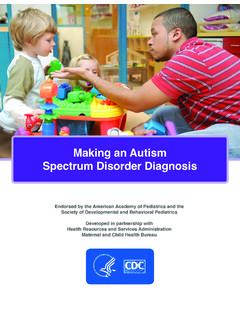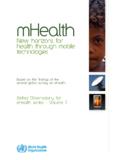Transcription of INTEGRATED MANAGEMENT OF PREGNANCY AND …
1 For maternal and Neonatal CareStandards INTEGRATED MANAGEMENT OF PREGNANCY AND CHILDBIRTH (IMPAC)Requirements A national policy and national strategies to achieve high vaccination coveragewith tetanus toxoid (TT or Td) among pregnant women are available and arecorrectly implemented. In countries with areas at high risk for MNT, strategies and plans to implement a high-risk approach , including vaccination of women of childbearing age, are inplace. the community. Antenatal care (ANC) providers have been trained in tetanus immunization.
2 The vaccine, equipment and supplies (refrigerator, syringes, needles, etc.) neededto conduct tetanus immunization are readily available in the health facilities,particularly at ANC services. immunization register, personal vaccination cards and maternal health records. All pregnant women are issued a personal immunization card, which should beavailable for reference at each ANC visit and at any other contact with the healthsystem throughout life. health education activities to increase community awareness of the importance oftetanus immunization are carried out.
3 maternal and neonatal tetanus are included in the national surveillance immunization against tetanusAll women giving birth and their newborn babies should be protectedagainst standardTo prevent maternal and neonatal tetanus (MNT).AimApplying the standardHealth providers of maternal and neonatal health care, in particular, must: Follow universal standards for prevention of infection in all circumstances. If the woman has a tetanus-prone wound, including a woman who underwentan unsafe abortion, protect her against future tetanus risks by immunizing her prophylaxis with tetanus immunoglobulins if the wound is large and possibly infectedwith soil or instruments contaminated with animal health maternal immunization against tetanusStandards mixes completely with the liquid.
4 If it is suspected that the vaccine has been frozen and thawed,check for damage using the shake test. Previously frozen vaccine should not be administered. In the ANC service, check the immunization status of the pregnant woman (either by historyor by card), regardless of whether there is an intention to continue the PREGNANCY . Administer DZ if the woman has not previously been vaccinated, or if her immunization status is unknown,give two doses of TT/Td one month apart before delivery, and further doses as per table 1; if the woman has had 1 4 doses of tetanus toxoid in the past, give one dose of TT/Td before Dz For the woman to be protected during PREGNANCY , the last dose of tetanus toxoid must be givenat least two weeks prior delivery.
5 Record the doses given on a standard tetanus toxoid immunization register and on a personalimmunization card or maternal health record. The personal immunization card should be keptwith the at last vaccinationPrevious immunizations Recommended ImmunizationsAt present contact/pregnancyLater (at intervals of Infancy3 DTP2 doses of TT/Td ( weeksinterval between doses)1 dose of TT/TdChildhood4 DTP1 dose of TT/Td1 dose of TT/TdSchool age3 DTP + 1 DT/Td1 dose of TT/Td1 dose of TT/TdSchool age4 DTP + 1 DT/Td1 dose of TT/TdNoneAdolescence4 DTP + 1 DT at 4-6 yrs + 1TT/Td at 14-16 yrsNoneNoneTable 2 Guidelines for tetanus toxoid immunization of women who were immunized during infancy, childhood or adolescencebbAdapted from: Galazka immunological basis for immunization series.)
6 module 3: , world health organization , 1993(WHO/EPI/ ), page 17. tetanus-containing vaccine ( DTP, DT, Td, TT) administer doses as indicated in the table 2. Dose of TT or Td (according to card When to giveExpected duration of protection1 None2 1-3 years3 pregnancyAt least 5 years4 pregnancyAt least 10 years5 pregnancyFor all childbearing age years andpossibly longer Table 1 Tetanus toxoid immunization schedule for women of childbearing age and pregnant women without previous exposure to TT, Td or DTPaaSource:Core information for the development of immunization policy.)
7 2002 update. Geneva. world health organization , 2002 (document WHO/ V& ), page maternal immunization against tetanusStandards AuditInput indicators A national policy and strategies and plans related to MNT are available in health facilities. ANC care providers are acquainted with the vaccination schedule and know how to checkwhether tetanus toxoid vaccine has been damaged. Community-based health education activities are carried out in order to increase ANC and TTimmunization coverage. Outreach activities are carried out in order to increase ANC and TT immunization and output indicators The proportion of ANC services providing tetanus immunization services.
8 The proportion of pregnant women immunized with at least two doses of tetanus toxoid (TT2+)or the proportion of neonates protected at birth (PAB). Monthly reports on NT cases are completed and delivered on indicators Incidence of neonatal tetanus (the target is less than 1 case per 1000 live births at district level). Incidence of maternal tetanus. Worldwide, tetanus kills an estimated 180 000neonates(1)(about 5% of all neonatal deaths(2002 data)) and up to 30 000 women(2)(about5% of all maternal deaths) each year. If themother is not immunized with the correctnumber of doses of tetanus toxoid vaccine,neither she nor her newborn infant is protectedagainst tetanus at is caused by a toxin produced duringthe anaerobic growth ofClostridium is acquired through environmentalexposure of any broken skin or dead tissue such as a wound or when the umbilical cordis cut to the spores of the bacteria.
9 Thesespores are universally present in the , poor hygiene and limited access tohealth services increase the risk of estimates that only 5% of NT casesare reported, even from countries with well-developed surveillance systems. Since 1989,when the world health Assembly calledRationalefor the elimination of NT, 110 out of 161developing countries are thought to haveachieved elimination (as of the end of 2004).UNICEF, WHO and UNFPA agreed in 1999to set the year 2005 as the target date for as the reduction of NT cases to less than 1per 1000 live births in every district of every proxy for the elimination of maternal tetanus.
10 The purpose of giving the vaccine to womenof childbearing age and to pregnant womenis to protect them from tetanus and to protecttheir newborn infants against NT(3,4).Tetanus vaccination produces protectiveantibody levels in more than 80% of recipients (1 3). Two doses protect for1 3 years, although some studies indicateeven longer protection(3). Tetanus vaccine issafe to give during PREGNANCY (4,5). possible and treat the baby according to national guidelines. A second dose should be given (at second.)













